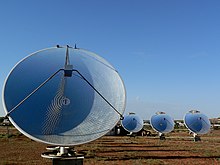Our website is made possible by displaying online advertisements to our visitors.
Please consider supporting us by disabling your ad blocker.
Renewable energy in Australia

Renewable energy in Australia is based mainly on biomass, solar, wind, and hydro generation technologies. Over a third of all electricity generated in Australia is renewable energy, a proportion that is increasing in line with global trends, with a target to phase out coal power before 2040.[1] In 2021 Australia overtook China in terms of renewable energy proportion, and as of 2024[update] has almost caught up with the European Union, but is still far behind Germany who overtook Australia in 2004.[2] Wind and rooftop solar energy in particular have grown since 2010.
This growth has been stimulated by government energy policy in order to confront the rate of climate change in Australia that has been caused by fossil fuels. Pros and cons of various types of renewable energy are being investigated, and more recently there have been trials of green hydrogen and wave power.
Australia ratified the Kyoto protocol in 2007, and in 2016 became a party to the Paris Agreement, an international agreement that binds member countries to address climate change. However, the level of fossil fuel subsidies in Australia is still disputed. The Australian Renewable Energy Agency (ARENA) was established as an independent government agency in 2012 to improve the competitiveness of renewable energy technologies and to encourage innovation in the industry. As of 2024[update] renewable energy is seen as a good investment,[3] and many companies operate in Australia, including BP Solar, Eurosolar, Hydro Tasmania, Origin Energy, and Pacific Blue.

| Source | Generation (GWh) |
|---|---|
| Wind | |
| Small solar | |
| Hydro | |
| Large solar | |
| Bioenergy | |
| Medium solar |
- ^ "Coal will be all but gone by 2034 under Australia's latest energy roadmap". UNSW Sites. Retrieved 25 March 2024.
- ^ "Share of electricity production from renewables". Our World In Data. 2024. Archived from the original on 27 December 2024. Retrieved 27 December 2024.
- ^ "Major Investors More Confident in Australia's Climate Policy". Bloomberg. 25 March 2024. Retrieved 25 March 2024.
- ^ Cite error: The named reference
:8was invoked but never defined (see the help page).
Previous Page Next Page


